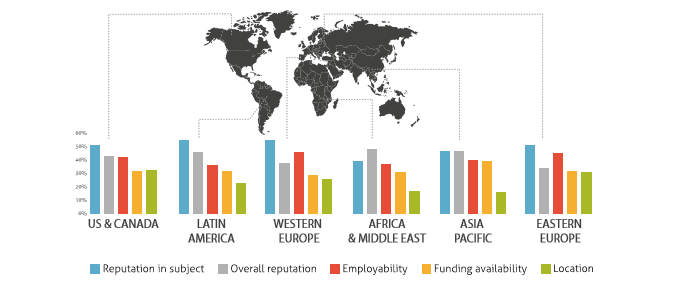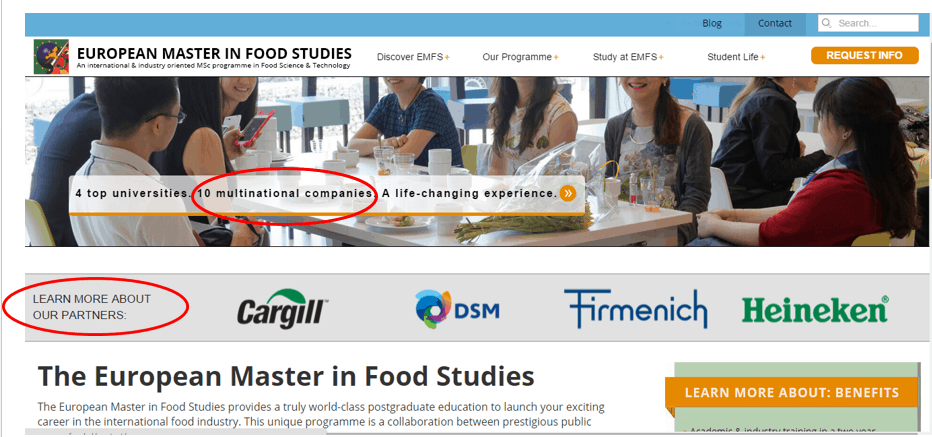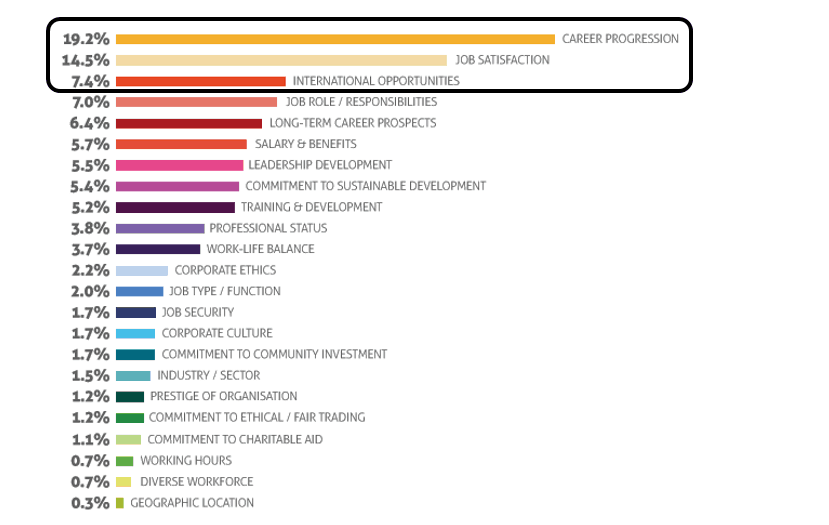
We looked at the QS World Grad School Tour: Applicant Survey 2015 to learn more about what drives postgraduate decision-making across the globe.
The survey collected responses from 7,153 students applying for graduate-level courses worldwide (master and PhD), and was conducted between late December 2014 and June 2015.
Participants came from the Asia Pacific region, Nigeria, Pakistan, Ghana, Italy, Brazil, the US, UK, Greece and Kenya – and 87% are in the process of selecting a master program. What’s fascinating is that, despite their diverse origins, these students report strikingly similar priorities when selecting a university and master program.
We’ll look at several of these top trends, analyze their impact on international student recruitment, and offer practical tips for aligning your digital tactics with master students’ top priorities.
Institution PLUS Program Reputation are Crucial: What’s Your Brand Message?
The QS survey tells us that verifying the “reputation” of both the institution and their chosen postgraduate program is of high importance to prospective applicants from across the globe.
Importance of “Reputation” to Prospective Postgraduates

But what does “reputation” really mean? Endorsement by prominent industry professionals? A high position in academic rankings? Prestigious faculty known for their expertise and contributions to the field? A lively student body and exciting campus?
What key marketing messages should Master programs focus on most when reaching out to international audiences?
This QS survey response offers valuable insight into how students define “reputation”:
“Rankings are important, but it’s not as important as the course you want to do, and how much attention is given to each student. What you are and who you want to be comes first.”
It seems that postgrad applicants are looking for institutions that genuinely understand their particular wants, needs, and goals – and can substantiate the depth of their understanding, commitment and accountability with concrete proof. Top rankings and other types of prestige branding aren’t enough to engender trust and prompt enquiry.
So, let’s examine what this means in detail, and precisely what kind of “proof” postgrad hopefuls are looking for when evaluating reputation. Then we’ll suggest some practical tips for highlighting these attributes strategically, across your digital channels.
“Employability” Trumps Personal Interest by a Wide Margin
The graph we looked at above shows that, in addition to reputation, “employability” is of primary concern for students considering grad programs.
The QS survey found that “almost 60% of master’s applicants say their prime motivation for further study is to progress in their current career, to improve their employment prospects more generally, or to enter a particular profession.”
And it’s no surprise that professional goals are motivating decision-making, especially when you consider that “applicants in every region of the world expect to more than double their current salary after completing a postgraduate degree.”
Salary Expectations After Earning a Postgraduate Degree

Personal interest in the area of study is still important to these students, but it only accounts for 11% of their total motivation for pursuing the master.
So what are students looking for when evaluating your institution and program from an employability standpoint? Here are a few KPIs to consider:
1. Market Demand & Projected Financial Security
Students want to ensure that their program of study leads to an in-demand career. Postgraduates are leaning more toward STEM, computing, and business-related fields because they believe those career paths will lead to the greatest financial security.
Master applicants in Western Europe were found to be the most influenced by market trends and concerns over financial security. The 2008 crisis hit the region particularly hard, making employability a top concern for the future.
Overall, it would be wise for institutions to highlight data that proves market demand is growing for the master graduates they produce. Don’t leave students to conduct their own research and analysis. Put this information up front across your digital channels.
2. Internships to Build Experience & Professional Networks
One way for institutions to boost their employability quotient is by offering high quality internships alongside academic coursework.
Students want to make professional inroads before they even graduate, bolstering their CV, making industry connections, and otherwise laying the groundwork for a smooth transition into full-time employment.
Postgrads will prioritize programs with prestigious industry partnerships and opportunities to gain real-world experience.
3. Opportunities for post-grad work in country of study
The QS survey found that 47% of master applicants hope to find work in their study destination country after graduation. They believe the destination country/city they’ve selected offers special advantages to new graduates – perhaps as a thriving hub for finance, a supportive market in which to start a business, or a well-funded base for exciting R&D. For these students, your institution’s employability rating is predicated on its capacity to open professional doors in the local environment.
Digital Tactics for Proving “Employability” to Prospective Applicants
1. Up-to-date graduate employment statistics are one of the best ways to prove your master programs are a safe investment for future students. QS survey respondent, Anamil, put it best:
“My main priorities are to firstly look at the employability rate of the course – I think this is the most important thing, to see if the university’s students get employed soon after graduating.”
Universities should ensure graduate employment rates are displayed prominently on their homepage, and across each master program page or microsite. Here’s how Falmouth University does it, on their main homepage image slider:

2. Emphasize your connections to industry leaders, and the opportunities your master students will have to engage with high profile companies and organizations. Here’s a good example from the European Master of Food Studies (EMFS), who offers students hands-on experience with leading international food companies:

3. Include blogging, news updates, testimonials, and graduate success stories in your student recruitment content strategy. Be sure to write and share narratives that showcase:
- the market value of your master programs
- the repeated success of your grads in the workforce
- how much current students value the personalized support they receive in class
- the scope and breadth of your career services
- exciting industry events held on campus, including career fairs, guest speakers, seminars, etc.
- alumni-hosted events for networking and mentorship
Include this content on your website, and distribute it across your social media channels. As much as possible, let your current students, alumni, and industry partners prove your “employability” in their own words. This way, you’ll naturally attract your target audience without resorting to less genuine, more obtrusive self-promotion.
International Degree Recognition is Priority #1 When Choosing Place of Study
Overall, QS survey respondents say they choose study destinations based on the international recognition of the university/degree, rather than other motivators like cultural exploration or personal interest.
Why is international recognition so important?
Part two of the QS survey (which looks at career expectations) reveals that postgraduates hope to earn jobs that are distinctly international in scope.
In fact, respondents’ number one career goal was to become either the CEO or Director of a large/public company – a position that undoubtedly requires universally recognized credentials, experience in the international marketplace, and expertise collaborating abroad with people from diverse backgrounds.
Respondents’ professional priorities also reflect the importance placed on global scope, with “international opportunities” ranking in the top three most important criteria for selecting an employer – even higher than “job role” and “salary/benefits.”
Postgraduates’ Criteria for Selecting an Employer

What does this mean for your recruitment marketing?
It goes without saying that institutions hoping to recruit international master students should emphasize global ties and opportunities. This could mean:
- promoting success stories of graduates who have gone on to hold prominent positions in international organizations
- highlighting your partnerships and internship opportunities with well- known global companies (like EMFS does in our previous example)
- showcasing your graduate acceptance rate into PhD programs at prestigious, internationally recognized universities.
Scholarships & Financial Aid Have Grown in Importance
The QS report found that, “compared to the 2008-9 survey results, scholarship/ financial aid availability has become more important for applicants in all regions.”
Given the extremely high value international students place on employability and financial security, it’s not surprising that affordability has moved more firmly into the spotlight.
Postgraduate applicants will look for institutions with robust student financial services. They may want access to campus work programs to help finance their studies, personalized support to help map out a feasible budget, assistance navigating scholarship applications, etc.
What does this means for your recruitment marketing?
Put financial support services, work-study programs, and any scholarships you offer front and center when formulating your content strategy for international student recruitment. Best practices include:
- prominent links to these services and opportunities on the international section of your website (and each master program section)
- highlight financial aid and scholarships in your email campaigns (include links to relevant content on your website)
- mentioned scholarships and financial aid resources in your internationally-oriented PPC ads (and corresponding landing pages)
- feature international scholarship winners on your website and social channels
- publish and promote testimonials about how your financial aid team has helped international students access funds and employment opportunities
Final takeaway
Universities hoping to attract international master’s applicants will need to consider how their “reputation” holds up against the measuring sticks of
- employability
- affordability
- international opportunity
Aligning your content strategy around these three KPIs can help strengthen your online presence, differentiate your programs from the competition, and create more opportunities to connect with (and convert) international target audiences.






